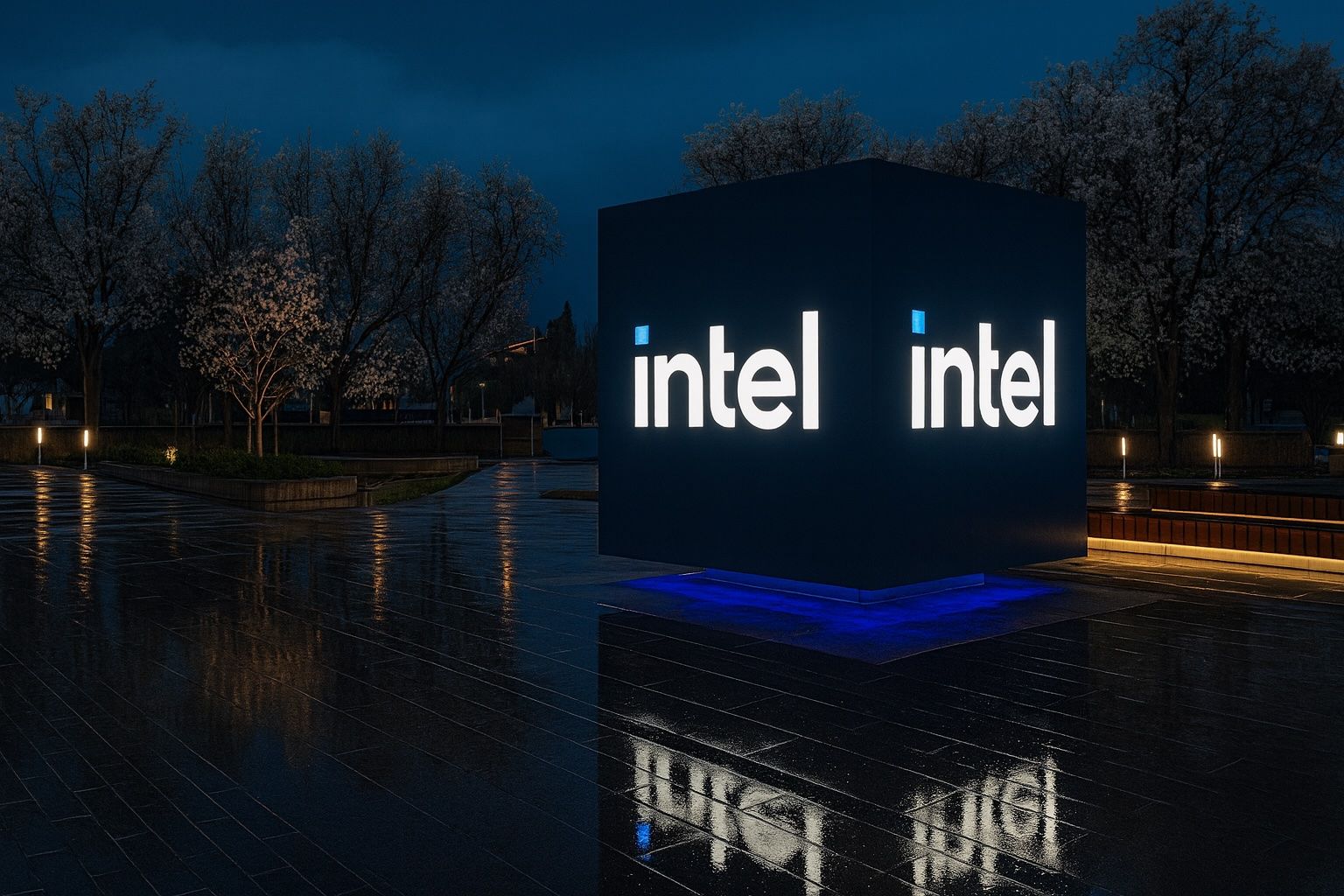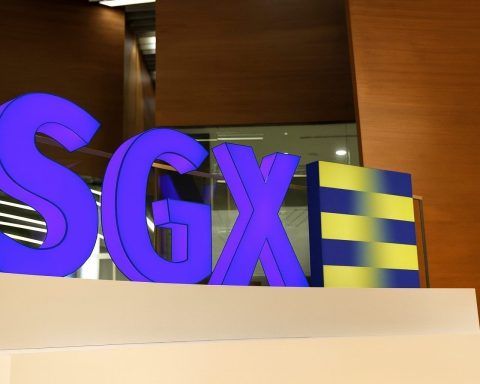- The White House is reportedly weighing a plan to take a 10% ownership stake in Intel by converting up to $10 billion of CHIPS Act grants into equity.
- The proposed 10% stake would be worth roughly $10-11 billion at current valuations.
- Intel was awarded about $10.9 billion under the CHIPS and Science Act for new fabs in Arizona, New Mexico, Ohio and Oregon.
- Intel appointed Lip-Bu Tan as CEO in early 2025 after the ouster of Pat Gelsinger.
- Tan met with President Donald Trump in the Oval Office in early 2025.
- Trump publicly demanded Tan resign over alleged ties to hundreds of Chinese semiconductor companies.
- If enacted, the move would be among the most significant U.S. government interventions in a private company since the 2008-09 financial crisis bailouts.
- Intel stock surged roughly 20-25% over a few days on stake-talk, the best week since the dot-com boom of 2000, with a market value of about $104 billion at one point.
- The plan would leverage the CHIPS Act to convert subsidies into equity to boost U.S. chipmaking and counter Beijing’s influence.
- Lawmakers would scrutinize governance, exit options, and taxpayer returns, with potential hearings and safeguards to prevent undue Chinese expansion.
Government Stake in Intel: Latest News and Context
In an unprecedented move, the White House is reportedly mulling a plan to take a 10% ownership stake in Intel Corp., one of America’s largest chipmakers [1]. Multiple outlets – from Fox Business to Bloomberg and Reuters – report that officials are in talks to convert up to $10 billion of federal semiconductor grants into equity in Intel [2]. Such a stake, worth roughly $10–11 billion at current valuations, would make the U.S. government Intel’s single largest shareholder [3] [4]. This bombshell proposal comes amid Intel’s struggles to regain technological leadership and is fueled by Washington’s push for domestic chip production in the face of rising competition from Asia [5].
The news first broke after a high-profile meeting in Washington that has quickly become the talk of both tech and political circles. Reports indicate the idea of a federal stake gained traction following a meeting at the White House between Intel’s leadership and the President [6]. According to Bloomberg’s scoop (as cited by Fox Business), that meeting set the stage for discussions of a government investment in Intel [7]. While official details remain scant – a White House spokesperson stressed that any such deal is “speculation” until formally announced [8] – the mere possibility has sent shockwaves through the semiconductor industry and financial markets.
A High-Stakes Meeting Sparks Talks
The backstory to this development reads almost like corporate drama. Just days before the stake rumor surfaced, Intel’s new CEO Lip-Bu Tan met with President Donald Trump in the Oval Office [9]. The meeting was anything but routine: it came on the heels of Trump publicly demanding Tan’s resignation over alleged ties to Chinese tech firms [10] [11]. “The CEO of Intel is highly CONFLICTED and must resign, immediately. There is no other solution,” Trump blasted on social media [12], after U.S. lawmakers raised concerns about Tan’s past investments in hundreds of Chinese semiconductor companies (including some linked to China’s military) [13] [14].
Instead of a resignation, what followed was a tense but “very interesting” meeting, as Trump described it [15]. In a remarkable about-face, the White House talks shifted from ousting the CEO to potentially partnering with Intel to bolster its finances and U.S. chipmaking capacity [16]. Media reports suggest President Trump came away impressed by Tan and directed his team to explore ways to support Intel’s turnaround [17] [18]. The idea on the table: take a chunk of ownership in exchange for the billions in federal grants Intel was already set to receive. Intel had been awarded around $10.9 billion under last year’s CHIPS and Science Act for U.S. factory projects [19] – an amount notably close to the value of a 10% equity stake. Converting those subsidies into stock would effectively make Uncle Sam a part-owner of Intel, aligning the company’s success with U.S. national interests [20].
Neither Intel nor the White House has officially confirmed these negotiations, declining to comment on “rumors or speculation” [21]. Yet leaks from officials “familiar with the matter” have been enough to ignite intense debate in Washington and Silicon Valley. If it proceeds, such a deal would mark one of the most significant U.S. government interventions in a private company in decades, outside of crisis bailouts. “Discussion about hypothetical deals should be regarded as speculation unless officially announced,” cautioned a White House spokesperson when pressed about the Intel talks [22]. Still, the very fact this option is being discussed at the highest levels underscores how strategic semiconductors have become – equated with national security as much as economic might.
National Security and Economic Motives
Why would the government consider buying into Intel? In a word: security. Chips are the brains of modern technology, from smartphones to fighter jets, and U.S. leaders have grown uneasy with the nation’s dependence on Asian manufacturers. Administration officials see shoring up Intel as a way to “advance more chipmaking in the U.S. vs. Asia” and protect national security [23]. A White House stake could tether Intel’s success to America’s technological self-reliance at a time when geopolitical tensions threaten global supply chains.
The plan essentially leverages the CHIPS Act – a $52 billion federal program passed in 2022 to boost domestic semiconductor production – in an innovative way. Instead of a traditional grant-for-factory funding model, the idea is to take equity, giving taxpayers an upside (and a say) in Intel’s future. Intel was one of the biggest CHIPS Act beneficiaries already, set to receive nearly $11 billion for new fabs in Arizona, New Mexico, Ohio and Oregon [24]. Those funds were intended to help Intel build huge chip plants (like the $100 billion Ohio “Mega-fab” complex) and regain its manufacturing edge. By converting that support into stock, the government aims to ensure its investment literally builds national capacity and doesn’t just pad a company’s balance sheet.
Officials also view the move as insurance against China’s own tech ambitions. “The U.S. government is taking a China card here and trying to have a little more control over some of the production,” observed market strategist Clark Geranen, noting Washington’s desire to counter Beijing’s influence [25]. China, for its part, has spent years heavily subsidizing its semiconductor champions and pursuing self-sufficiency in chips – a strategy U.S. policymakers now feel compelled to match. By partially “nationalizing” a chip giant, the U.S. would be emulating (in a limited way) Beijing’s playbook of state-backed tech development, all in hopes of outmaneuvering China in the silicon arms race.
There’s also a hard-edged industrial policy angle. Under President Trump, the U.S. government has embraced unprecedented corporate interventions to tilt the playing field in strategic sectors [26]. In just the past few weeks, Trump officials have rolled out a series of moves targeting the semiconductor supply chain. For example, the Defense Department recently took a $400 million equity stake in MP Materials – a Las Vegas-based rare-earth mining firm – to secure critical minerals for electronics [27] [28]. And in a dramatic bid to curb China’s access to advanced chips, the administration struck a deal requiring U.S. chip designers Nvidia and AMD to pay 15% of their Chinese AI-chip sales to the U.S. government [29]. Such aggressive measures, alongside talk of 100% tariffs on imported chips, signal a government dead set on protecting and elevating American tech firms – even if it means upending free-market norms [30].
Not everyone is on board with this approach. Free-market advocates and some lawmakers are uneasy about blurring the line between government and business. Skeptics argue that funneling taxpayer money into a private corporation – effectively partially nationalizing it – could set a risky precedent. “From a free-market point of view, it is something to be concerned about,” Geranen said of the Intel stake idea [31]. Traditionally, U.S. governments intervened in companies only as a last resort (for instance, the post-2008 auto bailouts). Doing so preemptively with Intel, which is troubled but not in immediate collapse, raises questions: Is this truly about national security, or is it an improper market distortion? The political debate is likely to be lively. Hawks in Washington argue that extraordinary times (a tech cold war with China) call for extraordinary measures to save a linchpin of U.S. tech. More libertarian voices counter that the government shouldn’t be in the business of picking winners and could be putting taxpayer dollars at undue risk if Intel can’t right the ship.
Market Reaction and Intel’s Stock Surge
On Wall Street, the mere whiff of a federal lifeline sent Intel’s stock soaring. Investors piled in amid speculation that an influx of government cash – and vote of confidence from the White House – could jump-start Intel’s comeback. Last week, Intel shares rocketed roughly 20–25% in just a few days [32]. In fact, the company enjoyed its best week in the stock market since the dot-com boom of 2000 [33]. The rally was spurred by the Bloomberg report of stake talks and optimism that Intel’s massive factory investments might be safer with Uncle Sam as a partner. By Thursday of that week, the stock at one point was up nearly 9% in a day, and ultimately closed 7.4% higher, valuing the company at about $104 billion [34].
However, the euphoria was tempered by uncertainty. When officials in Washington tried to downplay the story as hypothetical, some of Intel’s gains pulled back. On the following Monday, Intel’s share price slipped about 3.7% as traders took profits and waited for concrete news [35]. Still, year-to-date Intel is up around 18%, with much of that rise coming in anticipation of government support [36]. The market’s message seems clear: investors love the idea of a cash-rich government backstop for Intel – but they also know it’s not a done deal.
Broader semiconductor stocks had a mixed reaction. Rival chipmakers AMD and Nvidia initially saw their shares dip on the Intel news, according to market analysts, as investors pondered the U.S. government giving Intel a competitive edge. (Why back a laggard like Intel, some quipped, unless it really needs help to catch up?) But any sector fallout was short-lived; the overall Philadelphia Semiconductor Index remained near yearly highs, buoyed by surging AI-chip demand. Meanwhile, bond markets and credit analysts reacted positively for Intel, since a government equity infusion could shore up Intel’s finances without adding debt. Intel has been burning cash to build new fabs, and a $10 billion boost would greatly strengthen its balance sheet – theoretically reducing bankruptcy risk to near zero if the government becomes a stakeholder.
Investor sentiment is thus torn between optimism and realism. On one hand, a federal stake would be a game-changing vote of confidence in Intel’s future. On the other, it raises questions about dilution and government influence. “Federal backing could give Intel more breathing room to revive its loss-making foundry business,” note analysts, “but it still suffers from a weak product roadmap and customer challenges” [37]. In other words, money alone might not fix what ails the company (more on that below). As one veteran tech investor wryly noted, “If the government is stepping in to save a blue-chip company, it likely means Intel’s competitive position was much worse than anybody feared” [38]. That somber assessment hasn’t stopped traders from betting that Intel, with Washington’s help, will find a way to turn things around.
Reactions from Analysts and Industry Experts
The proposed Intel deal has experts across the spectrum fiercely debating its merits. Silicon Valley veterans, Wall Street analysts, and political figures have all weighed in with a mix of intrigue, praise, and skepticism.
Some industry voices applaud the bold intervention. Bob Nardelli, a former CEO of Chrysler and Home Depot, lauded the White House’s willingness to think outside the box to rejuvenate a flagship American company. “I think it’s proof-positive of how [the President] has really refined the art of the deal. It’s amazing what he has done in reshaping the global economy,” Nardelli said, praising the administration’s hands-on approach [39]. Proponents argue that semiconductors are a strategic resource akin to oil or steel in past eras – too important to be left to foreign control or to the whims of the market. If a public-private partnership is what it takes to restore U.S. chip leadership, they contend, then so be it.
Financial analysts, however, have offered more nuanced takes. “It could be a real game-changer for Intel,” said Matt Britzman, senior equity analyst at Hargreaves Lansdown, noting that an injection of capital and confidence from Washington would provide crucial support [40]. But Britzman quickly added a caveat: “Government support might help shore up confidence, but it doesn’t fix the underlying competitiveness gap in advanced nodes.” [41] In plain English, Intel’s core problem is technological – it fell behind in making the fastest chips – and no amount of money guarantees a catch-up in cutting-edge chip manufacturing. The sentiment was echoed by analysts at Bernstein, who issued a stark warning: “Intel also needs capability; can the U.S. government do anything to help here? Without a solid process roadmap the entire exercise would be economically equivalent to simply setting tens of billions of dollars on fire.” [42]
That blunt assessment highlights a key point: Intel has stumbled in the race for technology as much as for funding. Years of missteps allowed Taiwan’s TSMC to seize the lead in producing the most advanced chips, while Intel is still ironing out the kinks in its latest 18A fabrication process [43]. Intel’s products have also lagged – it missed the boat on chips for the booming AI market, ceding that territory to Nvidia, and it’s been losing market share in PC and data center processors to a resurgent AMD [44]. Given those realities, some experts worry that Washington might be effectively “buying the dip” on a company whose problems are more structural than cyclical.
From the perspective of Intel’s leadership, any public comments have been scarce (understandably, given the sensitivity of ongoing talks). CEO Lip-Bu Tan has tried to project confidence in Intel’s long-term strategy, while also adopting a more cautious approach than his predecessor. Notably, since taking over in early 2025 after the ouster of Pat Gelsinger, Tan scaled back some of Intel’s grand expansion plans, opting to build new factories more slowly and only in line with concrete customer demand [45] [46]. That pragmatism may have clashed with Washington’s urgency for a manufacturing boom – one report noted Tan’s strategy could “put him at odds with Trump’s push to bolster American manufacturing” [47]. Insiders say Tan is walking a tightrope, trying to avoid overextending Intel again, even as the company welcomes federal help. If a deal goes through, it may come with political expectations that Intel “go big” on U.S. production capacity, which could test the new CEO’s more measured philosophy.
On the political front, reactions have also been split. Republicans like Senator Tom Cotton, who originally sounded alarms about Intel’s CEO and his China connections, appear supportive of a tougher stance to protect U.S. tech. (Cotton’s probing letter to Intel’s board in August, highlighting Tan’s past investments in Chinese chip firms, arguably set in motion the chain of events leading here [48] [49].) Many GOP China hawks see a partial Intel nationalization as a justified defensive move in an economic war. Democrats, meanwhile, find themselves in an unusual position – the Biden administration championed the CHIPS Act to subsidize companies like Intel, but it’s Trump who may seize equity in the firm. Some Democrats are likely to back any plan that secures American manufacturing jobs, though progressive skeptics could question if public money is being used effectively. Thus far, no major party figure has openly opposed the idea, but as negotiations progress one can expect hearings and debate on Capitol Hill about the propriety of the government owning a slice of a private tech giant.
Perhaps the most candid perspective came from David Wagner of Aptus Capital Advisors, an Intel shareholder. “The fact that the U.S. government is stepping in to save a blue-chip American company likely means Intel’s competitive position was much worse than what anybody feared,” Wagner observed, reflecting concern beneath his firm’s cautious support [50]. Wagner admitted to being “skeptical” of using taxpayer money this way, yet conceded it might be “better than having Intel become a state-owned entity.” [51] In other words, if the alternative is Intel failing or falling into foreign hands, a U.S. stake is the lesser of two evils. It’s a sobering take: this deal, if it happens, is both a lifeline and a warning sign about how far Intel – once the unrivaled king of chips – has fallen behind.
Impact on Semiconductor Rivals
The ripple effects of a U.S. government stake in Intel would be felt across the global semiconductor landscape. Intel’s competitors – from American chip designers to Asian manufacturers – are closely watching what could become a new paradigm of state-backed competition.
For AMD and Nvidia, the two chief rivals who have been outperforming Intel in recent years, the prospect of a rejuvenated Intel backed by federal resources is a double-edged sword. In the short term, any boost to Intel’s manufacturing might actually benefit firms like AMD and Nvidia, which rely on outsourced chip production and are eager for more U.S.-based fabrication options. (Both currently depend heavily on Taiwan’s TSMC to manufacture their most advanced chips.) If Intel’s foundry business (contract manufacturing of chips) gets a shot in the arm, Nvidia could someday diversify its suppliers by building some GPUs at Intel fabs, for example. AMD’s CEO Lisa Su has already shown openness to outsourcing to Intel’s foundry if it becomes competitive. From this angle, some in the industry quietly cheer the notion of a stronger Intel, since it could alleviate supply bottlenecks and reduce overreliance on TSMC.
On the flip side, Intel is also a direct competitor in CPUs, and government aid could tilt that playing field. AMD has been steadily eating into Intel’s share of the PC and server processor market by offering cutting-edge chip designs. If Intel is able to accelerate its technology roadmap with government help, AMD’s hard-won gains might prove short-lived. Nvidia, too, competes with Intel in emerging domains like autonomous vehicle chips and networking. A well-funded Intel could invest more aggressively in R&D, potentially threatening those rivals down the line. It hasn’t escaped notice that Trump’s administration is pressuring Nvidia and AMD in other ways – like imposing a levy on their China sales [52] – while simultaneously considering a boost to Intel, an American manufacturer. This suggests a strategic favoritism: design companies that heavily rely on Asian fabs are being constrained, while a domestic producer like Intel is being favored. Such policy moves could gradually shift the competitive balance, steering the industry back toward U.S.-made silicon and away from the fabless model that Nvidia/AMD epitomize.
Then there’s Taiwan’s TSMC and South Korea’s Samsung, the giants of chip fabrication. They stand as the most advanced chip manufacturers today – and also as the implicit targets of U.S. industrial strategy. Intel’s fall from process leadership over the last decade allowed TSMC and Samsung to dominate cutting-edge chip production, especially for high-performance and AI chips. A resurgent Intel, propped up by Washington, would directly challenge TSMC and Samsung’s dominance in the long run. The U.S. clearly wants more of the world’s chipmaking done on American soil, to reduce dependency on Asian supply chains. If Intel can finally catch up technologically (a big “if”), government backing might encourage Apple, Qualcomm, and others to fab their chips stateside at Intel rather than at TSMC/Samsung foundries abroad.
In the near term, TSMC and Samsung might actually benefit from Intel’s continued struggles – the longer Intel needs to right itself, the more business flows to those Asian firms. Notably, Intel has had to rely on TSMC to manufacture some of its own products in recent years (for example, graphics chips), an irony that underscores its lag. Even with government aid, Intel’s turnaround will take time, and TSMC and Samsung will continue raking in orders in the meantime. However, both companies are now navigating a world where governments are picking sides. TSMC is investing $40 billion into new fabs in Arizona (with U.S. subsidies from the CHIPS Act) but has encountered delays and cost overruns, showing the challenges of transplanting its manufacturing model. Samsung too is expanding in Texas with help from U.S. incentives. The entrance of the U.S. government as a direct investor in a chip company ups the ante – it signals to TSMC and Samsung that their once purely commercial competition with Intel now has geopolitical overtones.
We could see foreign governments respond in kind. In South Korea and Taiwan, officials have historically supported their chip champions through incentives, but not direct equity stakes. If the U.S. breaks that taboo with Intel, those countries might consider new protective measures or subsidies to keep their firms competitive. It’s essentially the dawn of “chip nationalism”, where every major economy will go to greater lengths to secure semiconductor supremacy or at least self-sufficiency.
Meanwhile, smaller chip firms and equipment suppliers also feel the ripple effect. Companies like GlobalFoundries (another U.S.-based fab), or Europe’s upcoming Intel-backed fab projects, may worry that a government-favored Intel will soak up funding or talent. On the other hand, any investment that strengthens the U.S. semiconductor ecosystem could benefit the whole supply chain – from toolmakers like Applied Materials to materials suppliers – due to increased production activity. In short, the entire semiconductor industry is bracing for a paradigm shift: competition will no longer be just about who has the best tech or business model, but also about whose government is standing behind them with deeper pockets.
Geopolitical Ripple Effects: China, Taiwan, and Beyond
The Intel stake saga is not just a business story – it’s quickly become a geopolitical flashpoint, illustrating the growing tech tensions between the U.S. and China and the strategic importance of Taiwan. Beijing and Taipei are both eyeing these developments, albeit from very different perspectives.
In China, the news of a potential U.S. stake in Intel has likely validated long-standing suspicions about Washington’s intent. Chinese officials and state media often argue that America’s semiconductor initiatives are aimed at containing China’s rise. Indeed, President Biden’s push in 2021–2022 to onshore chip manufacturing was explicitly framed as a response to China’s advancements [53] [54]. Now, President Trump’s even more direct intervention with Intel underscores that the U.S. sees leadership in chips as a national security imperative – and implicitly, as a tool to keep China in check. The Global Times, a Chinese state newspaper, has previously accused Washington of weaponizing semiconductor policy: “The US has elevated the development of the chip industry into a national strategy for political gains,” Chinese analysts wrote, calling U.S. moves part of a plot to “sever global industry cooperation” and isolate China [55] [56]. We can expect similar rhetoric to intensify.
From Beijing’s viewpoint, a U.S. government foothold in Intel could look like overt techno-nationalism – the kind of state-guided capitalism that U.S. officials themselves have criticized China for. Chinese leaders may cite this as hypocrisy, pointing out that while the U.S. pressures China’s firms (like telecom giant Huawei) and restricts Chinese access to chips, it is now literally investing in an American chipmaker to ensure its dominance. This will likely fuel China’s resolve to double down on its own semiconductor self-reliance programs. Over the past decade, China has poured billions into domestic chip companies (such as SMIC and Hua Hong) and set ambitious goals to replace foreign chips with homegrown tech. If anything, the Intel episode is a vivid reminder to Beijing that it cannot rely on U.S. technology. Expect China to respond by accelerating support for its chip sector – perhaps by injecting more state funds, pushing state-owned enterprises to buy Chinese chips, or by redoubling efforts to develop breakthrough technologies free of U.S. patents. The tech “arms race” could thus escalate, with each country increasing government involvement in semiconductors to outmaneuver the other.
Nowhere is this rivalry felt more acutely than in Taiwan, home to TSMC and a linchpin of the global chip supply. The U.S.’s interest in bolstering Intel is in part an insurance policy against worst-case scenarios involving Taiwan, which lies just 100 miles off China’s coast. In strategic circles, there is open discussion that if China were ever to seize or blockade Taiwan, the U.S. and the world could be cut off from TSMC’s cutting-edge chips – a devastating prospect for the tech economy. By propping up Intel and manufacturing in America, the U.S. reduces the leverage Beijing might gain over global tech via any Taiwan conflict. Taiwan’s government, led by President Tsai Ing-wen, likely views the U.S. stake plan with cautious understanding. Taiwan has welcomed the CHIPS Act and U.S. interest in onshoring some chip production (TSMC’s Arizona fabs are partly a result of U.S.-Taiwan cooperation on this front). At the same time, TSMC’s dominance is a source of pride and bargaining power for Taiwan. If Intel were to eventually reclaim process superiority with U.S. backing, Taiwan’s strategic importance could diminish – something not lost on Taipei’s policymakers.
For now, TSMC executives have maintained that they don’t fear fair competition. When asked about the U.S. boosting Intel, TSMC’s leaders usually emphasize that manufacturing expertise can’t be bought overnight, and that they plan to stay ahead through relentless innovation. But one can imagine some private unease in Hsinchu (Taiwan’s Silicon Valley): If the U.S. government is going “all in” on Intel, TSMC faces a future where its primary rival has the explicit sponsorship of TSMC’s biggest customer nation. Taiwanese officials might quietly lobby for continued U.S. support as well – reminding Washington that TSMC is also investing in America and that a robust partnership with Taiwan’s industry remains crucial.
Other U.S. allies and adversaries are watching, too. In Europe, which has its own EU Chips Act, leaders may feel pressure to take similar bold steps. The European Commission has been funding new Intel fabs in Germany and encouraging TSMC to set up shop in Europe. If the U.S. taking an equity stake proves successful, European governments might contemplate stakes or golden shares in key chip firms to ensure their interests are protected. Japan and South Korea – both key players in chip manufacturing (from memory chips to displays) – are likewise weighing how to balance market forces with national strategy. Notably, Japan recently subsidized a new chip consortium called Rapidus, and South Korea is offering huge incentives to Samsung and SK Hynix; these moves are in line with the global tilt toward industrial policy in tech.
Finally, for countries like Russia, Iran, or others facing U.S. sanctions, the spectacle of America fortifying its tech base will reinforce their own decoupling efforts. We are likely entering an era where technological spheres of influence harden – with the U.S. and its allies on one side, and China and aligned states on the other – each block trying to secure supply chains within itself. The Intel partial-nationalization concept is striking because it shows the U.S. willing to do something it hasn’t done much since the Cold War: directly intervene in industry to ensure it wins a high-stakes global competition.
Historical Parallels and Legislative Outlook
While unprecedented in recent memory, the notion of Uncle Sam owning a slice of a major company does have some historical echoes. During the 2008–09 financial crisis, the U.S. government took equity stakes in banks and auto makers to prevent their collapse – famously becoming a shareholder of General Motors as part of the auto bailout [57]. In that case, the Treasury eventually sold its GM shares by 2013 once the company recovered. The Intel proposal differs in that Intel is not on the verge of bankruptcy, but rather struggling to regain competitiveness. A more relevant analogy might be the defense sector: the government frequently invests in defense contractors through R&D contracts and guaranteed purchases, though it typically doesn’t hold equity. Intel’s situation straddles these lines – it is a private enterprise in trouble, but one whose health is deemed critical to national defense and economic security (especially as Intel also produces chips for the U.S. military).
Legally, executing this plan may not require new legislation. The CHIPS and Science Act of 2022 provided the Commerce Department with tens of billions to distribute to chip companies, mostly as grants and incentives. What’s being contemplated is effectively converting some of that already authorized funding into a different form – equity – in agreement with Intel [58] [59]. The Commerce Department and Department of Defense (which also administers some chip funds for national security) arguably have latitude to structure deals creatively, as we saw with the Pentagon’s equity stake in MP Materials. Still, Congress will likely provide oversight. Lawmakers could call for hearings to ensure that any such equity arrangement is in the public interest, doesn’t unduly enrich Intel’s executives, and includes safeguards (for example, perhaps limiting the government’s voting rights or outlining an exit strategy for the stake). If the White House proceeds, expect intense scrutiny from congressional committees on how the deal is structured. Issues like: Will the government have a say in Intel’s governance? Under what conditions would the government sell its stake? How will returns to the taxpayer be realized? – all will be debated.
Another legislative angle is the question of reciprocity and restrictions. Under CHIPS Act rules, companies taking U.S. money must agree not to expand certain advanced operations in China and not to use funds for stock buybacks. Intel has already agreed to those terms for its grants. If those grants turn into shares owned by the government, Intel will remain bound by “guardrail” provisions to prioritize U.S. interests. In fact, the existence of those guardrails is part of why some officials favor an equity stake – it keeps Intel aligned with U.S. policy goals (like not boosting production in China) while giving the government a more tangible stake in the outcome.
Looking ahead, the outcome of the Intel stake talks could set a precedent for U.S. tech policy. If it succeeds – meaning Intel’s fortunes improve and the U.S. gains a secure supply of homegrown advanced chips – it may pave the way for similar arrangements in other critical industries (imagine government stakes in quantum computing companies or battery manufacturers deemed vital). It would mark a new era of public-private partnership in tech. On the other hand, if the plan falters – say, negotiations break down or the investment doesn’t yield the desired technological progress – it could serve as a cautionary tale against government overreach.
For now, the world is watching as this bold experiment unfolds. Intel’s board and the White House are likely deep in discussions, hammering out what a deal could look like. Will it be a direct government ownership, or perhaps a special non-voting share? Will it come with conditions on Intel’s management? Those details, when and if announced, will determine how palatable the arrangement is to various stakeholders.
Conclusion: A Turning Point for Tech Policy
The possibility of the U.S. government taking a significant ownership stake in Intel underscores just how critical the semiconductor sector has become – economically, politically, and geopolitically. This saga represents a turning point: the U.S. is signaling that maintaining leadership in chip technology is a national priority worth bending traditional free-market norms. The move intertwines the fate of a private corporation with the strategic interests of the state in an almost unprecedented way for the tech industry.
For Intel, it’s a chance at redemption – a lifeline to regain its former glory with a powerful partner at its side. For the Biden and Trump administrations (past and present), it’s the culmination of efforts to secure supply chains and outcompete China, from the CHIPS Act to aggressive deal-making. For rivals like AMD, Nvidia, TSMC, and Samsung, it’s a new challenge to adapt to an American competitor with the might of the U.S. Treasury behind it. And for global tech governance, it raises profound questions about how far governments should go to foster “national champions” in critical fields.
As of August 2025, the 10% Intel stake remains a proposal – a bold idea being hashed out in the corridors of power. Investors and industry leaders will be watching closely in the coming weeks for an official announcement or clarification. Whether or not the deal materializes, the issues it spotlights are here to stay. The semiconductor industry is now a centerpiece of geopolitics, and nations are pulling out all the stops to secure their place in the silicon hierarchy. In the words of one market expert, Washington’s moves show that “the U.S. government is playing the ‘China card’ here” in a high-stakes game for tech supremacy [60]. How that game ends could reshape not just Intel’s future, but the global technological order for years to come.
Sources:
- Fox Business – “White House mulls 10% stake in Intel after CEO meeting” [61] [62] [63] [64]
- Reuters – multiple reports on Intel stake discussions and related market reactions [65] [66] [67] [68]
- Reuters – “Intel shares rise on report of possible US government stake” [69] [70] [71] [72]
- The Guardian – “Intel shares jump after report says Trump administration looking at stake” [73] [74] [75] [76] [77]
- Reuters – “Exclusive: US lawmaker questions Intel CEO’s ties to China…” [78] [79] and Reuters (Max Cherney) reporting on Lip-Bu Tan’s China investments [80].
- Calcalist/CTech via Reuters – “White House weighs $10 billion Intel stake through Chips Act conversion” [81] [82]
- Reuters – “Trump administration in talks to take 10% stake in Intel…” (Zaheer Kachwala) [83] [84] [85].
- Global Times – Chinese perspective on U.S. chip strategy [86] [87].
References
1. www.foxbusiness.com, 2. www.reuters.com, 3. www.quiverquant.com, 4. www.quiverquant.com, 5. www.foxbusiness.com, 6. www.calcalistech.com, 7. www.foxbusiness.com, 8. www.theguardian.com, 9. www.calcalistech.com, 10. www.theguardian.com, 11. www.theguardian.com, 12. www.theguardian.com, 13. www.reuters.com, 14. www.reuters.com, 15. www.reuters.com, 16. www.theguardian.com, 17. www.foxbusiness.com, 18. www.foxbusiness.com, 19. www.reuters.com, 20. www.reuters.com, 21. www.theguardian.com, 22. www.theguardian.com, 23. www.foxbusiness.com, 24. www.foxbusiness.com, 25. www.reuters.com, 26. www.reuters.com, 27. www.quiverquant.com, 28. www.quiverquant.com, 29. www.theguardian.com, 30. www.theguardian.com, 31. www.reuters.com, 32. www.foxbusiness.com, 33. www.foxbusiness.com, 34. www.theguardian.com, 35. www.reuters.com, 36. www.foxbusiness.com, 37. www.reuters.com, 38. www.reuters.com, 39. www.foxbusiness.com, 40. www.reuters.com, 41. www.reuters.com, 42. www.reuters.com, 43. www.reuters.com, 44. www.reuters.com, 45. www.calcalistech.com, 46. www.calcalistech.com, 47. www.calcalistech.com, 48. www.theguardian.com, 49. www.theguardian.com, 50. www.reuters.com, 51. www.reuters.com, 52. www.theguardian.com, 53. www.globaltimes.cn, 54. www.globaltimes.cn, 55. www.globaltimes.cn, 56. www.globaltimes.cn, 57. www.reuters.com, 58. www.reuters.com, 59. www.reuters.com, 60. www.reuters.com, 61. www.foxbusiness.com, 62. www.foxbusiness.com, 63. www.foxbusiness.com, 64. www.foxbusiness.com, 65. www.reuters.com, 66. www.reuters.com, 67. www.reuters.com, 68. www.reuters.com, 69. www.reuters.com, 70. www.reuters.com, 71. www.reuters.com, 72. www.reuters.com, 73. www.theguardian.com, 74. www.theguardian.com, 75. www.theguardian.com, 76. www.theguardian.com, 77. www.theguardian.com, 78. www.reuters.com, 79. www.reuters.com, 80. www.theguardian.com, 81. www.calcalistech.com, 82. www.calcalistech.com, 83. www.reuters.com, 84. www.reuters.com, 85. www.reuters.com, 86. www.globaltimes.cn, 87. www.globaltimes.cn










